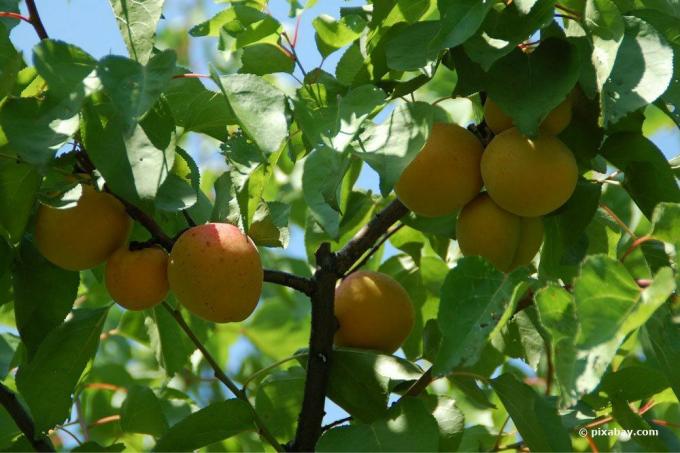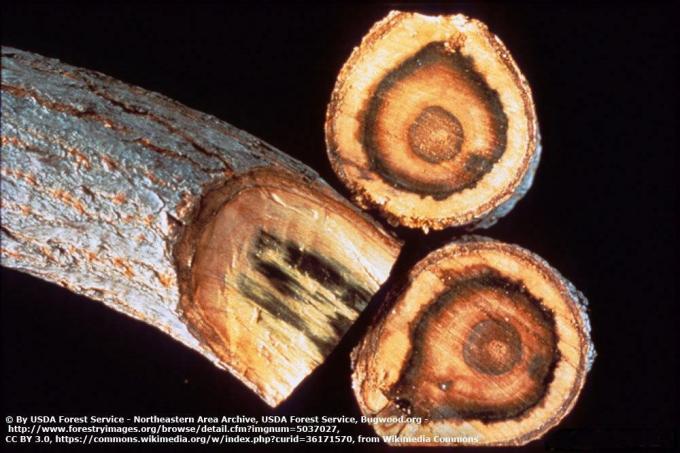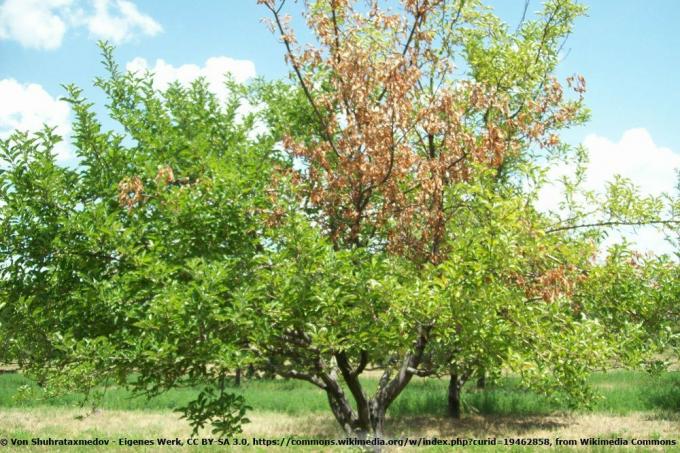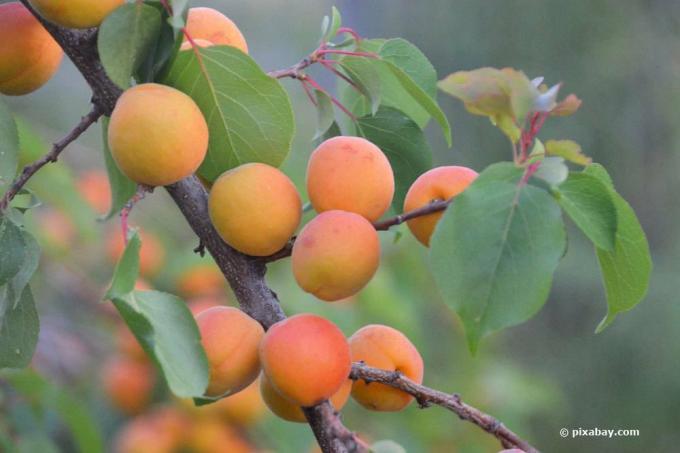
table of contents
- causes
- Verticillium wilt
- measures
- apoplexy
- measures
- Monilia laxa
- measures
- General prophylactic measures
- Plant strengthening through natural remedies
The warmth-loving apricot tree originally comes from Armenia and China. Today it is widespread in our regions and sometimes also under the name Apricot tree known. Not only is it so popular because of its sweet fruits, but it is also relatively easy to care for. Because apricot trees do not make great demands on the soil. But they love a warm, rain- and wind-protected location. However, water should only be given regularly in dry periods. In early summer, with dry weather and high temperatures, the leaves on the apricot trees can hang limply, begin to wither and ultimately fall off. In this case it is necessary to get to the bottom of the causes.
causes
Wilted leaves are not due to a lack of water
At first glance, such a sight can quickly lead to the assumption that a lack of water causes the leaves to wither and dry up, as this phenomenon usually occurs in dry periods. But watering cannot help the tree here either. The plant continues to slowly dry out. The cause of this can be a sign of various diseases, such as:
- Verticillium wilt
- apoplexy
- Monilia laxa
Verticillium wilt
This disease is caused by the harmful fungi Verticillium dahilae (dark microsclerotia) and Verticillium albo-atrum (permanent mycelium). Their fungal spores can survive in the soil for more than ten years without a host plant. You can access the root, for example after pruning the roots, in the plants, where toxins form and ultimately clog the waterways of the tree. Signs are:
- Leaves wither to the point of falling off
- Reduction in leaf growth
- Cracks on branches and shoots
- Balding and death of individual shoots, later also entire branches
- The whole tree dies after a few years
- Usually only one-sided at first
- Additional appearance of leaf yellowing and necrosis possible
- Sluggish course of the disease
- Dry periods and high temperatures accelerate the process
- Fruits are small and sometimes inedible
- Unambiguous proof only through laboratory examination of the soil
tip: By scratching the bark close to the ground or on the affected shoots, the water ducts underneath have a brownish discoloration.

measures
It is not possible to use fungicides on Verticillium wilt
So far, it has not been possible to directly combat the harmful fungi by chemical means. If the first symptoms become visible, the following should be acted on:
- Carefully rake together fallen leaves and dispose of with household waste
- Remove dead branches and twigs directly at the roots
- Don't leave stumps
- Seal cuts
- Cut diseased shoots far into the healthy wood, at least 50 cm
- Use clean and sharp cutting tools
- Carrying out pruning measures in dry, sunny weather
- Completely remove dead trees
- Renew the earth if necessary
tip: Ring-shaped dark discolorations in the area of the ducts indicate Verticillium wilt in the case of a cross-cut branch.
apoplexy
Apoplexy in apricots is also called Strike meeting known. Apricot trees can die off within a very short time. The cause can be damage caused by the cold due to winter or late frosts. These lead to damage to the ducts under the bark. This is particularly critical with apricots, as they are the first to end winter dormancy, and then late frosts usually occur. However, a heavy crop of fruit in the previous year, bacterial blight, shotgun disease or Monilia laxa can also promote the occurrence of the “hit”. First signs of apoplexy:
- After the initial shoot, leaves and shoots wilt
- Assault on individual twigs, branches or the entire crown
- Typical rubber flow below wilting areas (blockage of ducts)
- Torn bark on strong branches and trunk area
- Highest death rate between 3. and 7. Standing year
measures
Strengthen tree health and frost resistance
Immediate action should be taken at the first signs of apoplexy.
- Remove dead branches at the end of May
- However, stress from high fruiting or strong growth with a lack of yield
- Balanced fruit thinning, at least one fruit per hand
- When replanting, ensure that the apricots are frost-hardy
Monilia laxa
Monilia laxa is also called Peak drought known. Infection with the fungus Monilia laxa occurs from bud formation until after flowering. The mycelium spreads rapidly and penetrates the fruit wood. The peak drought is also favored by high precipitation. However, the fungal spores can also overwinter on the dried leaves, twigs and fruit mummies on the tree. Since they have a high germination capacity, they multiply quickly in the spring after flowering. It then spreads through rain, wind and insects. The following symptoms should be observed:
- Black discoloration of the stigma
- Pale green leaves on annual wood
- 3 to 4 weeks after flowering, shoot tips, flowers and leaves wither
- Encroachment on entire branches, leads to peak drought
- Rubber flow at the boundary between diseased and healthy tissue
measures
Cut back in case of infestation
In order to avoid further damage, action must be taken as quickly as possible in the event of an infestation with Monilia laxa.
- Chemical treatment is no longer possible in the event of infestation
- Cut out all infected branches, infected flowers and fruit mummies
- Cutting back dying branches up to 30 cm in healthy wood
- Preventive fungicide spray (mushroom-free Ectivo or Duaxo Universal mushroom-free)
- In addition, spraying at full bloom

General prophylactic measures
In order to avoid an outbreak of disease from the outset, you should pay attention to a few things. Because here it is advisable to combine various preventive measures. Nothing stands in the way of a lush harvest of the delicious sweet fruits over the years.
- Choose the optimal location, light, well-drained soil in a protected location
- Avoid soils with waterlogging, improve if necessary
- Do not plant too deeply, do not damage the roots
- Use tree snorkels when planting
- If necessary, lower the pH value of the soil by adding grape pomace, compost made from conifers or peat
- If necessary, replace the entire soil
- Soil improvement by incorporating active plant substances (e.g. radish or mustard plants)
- Balanced water and nutrient supply
- Avoid drought stress through regular watering
- Fertilization with compost, potash or horn meal and shavings
- Avoid nitrogen-based fertilization
- Regular thinning and cutting back
- Immediately close open cuts
- Do not leave branch stumps and fruit mummies standing
- Correct choice of varieties, such as Goldrich, Sylvevcot, Bergarouge, Harlayne
tip: Tree snorkels are jute sacks filled with expanded clay for good root ventilation. In order to avoid root damage in the event of subsequent installation, it is advisable to hire a specialist company.
Plant strengthening through natural remedies
Only healthy and strong trees have good disease resistance. However, in order to keep the plant cells healthy and at the same time strengthen them, biological strengthening agents can also be administered. Manure from field horsetail, nettle, tansy, comfrey or wormwood have proven effective. These can be made yourself quickly and without much effort, such as manure made from field horsetail:
- Pour 5l of water over 500g of fresh field horsetail
- Let brew for 3 hours, heat, simmer for 30 minutes
- Strain after cooling
- Use every 2 weeks for at least 4-6 weeks
tip: Preparations made from algae extracts and essential oils to strengthen resistance are also available in specialist shops. But there are also inorganic strengthening agents such as silicates, carbonates and phosphorus and potassium salts.


